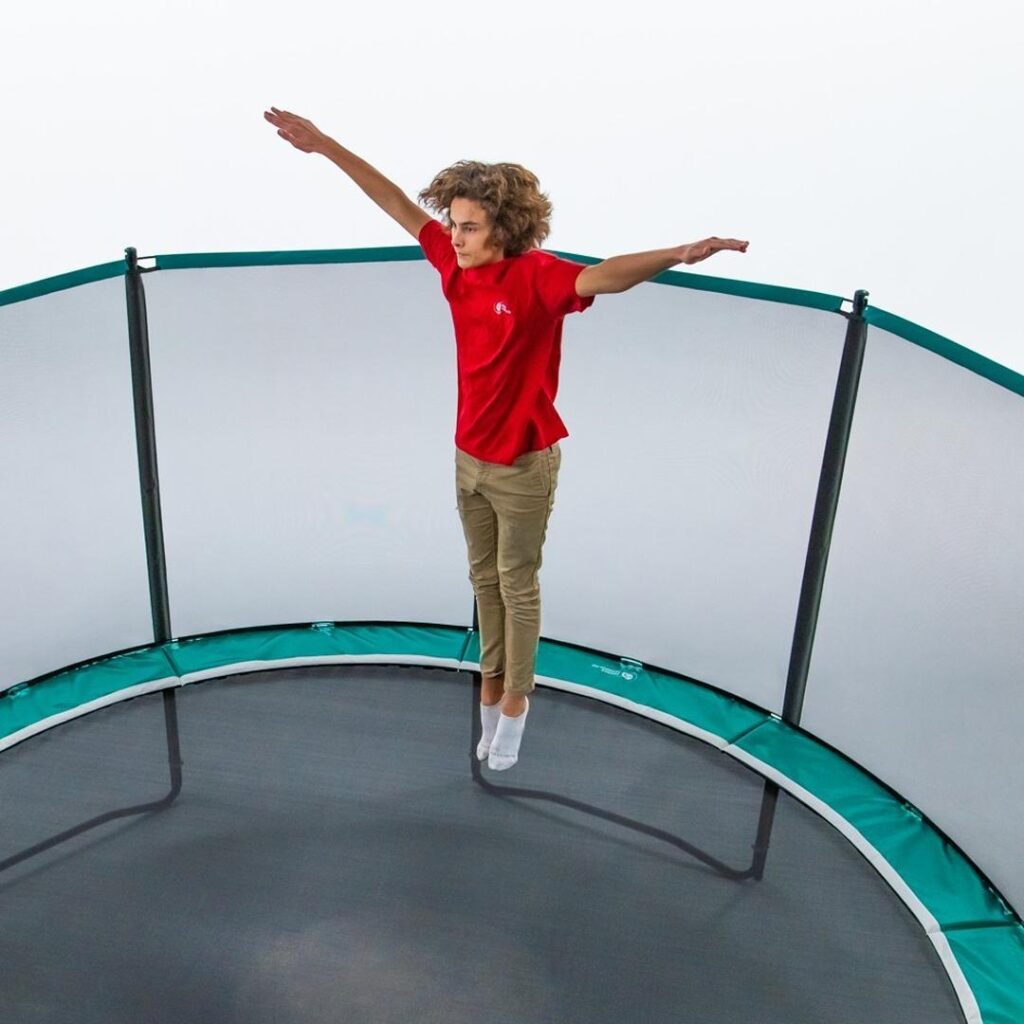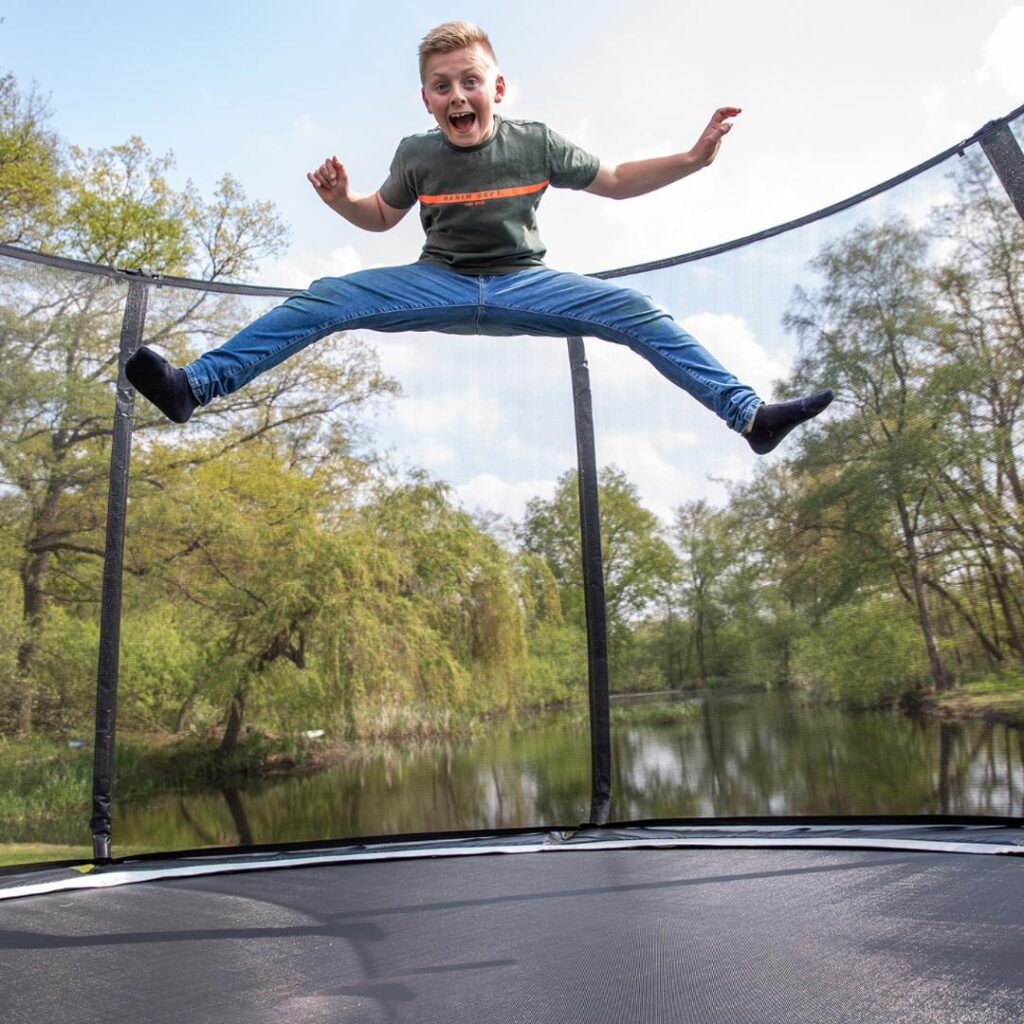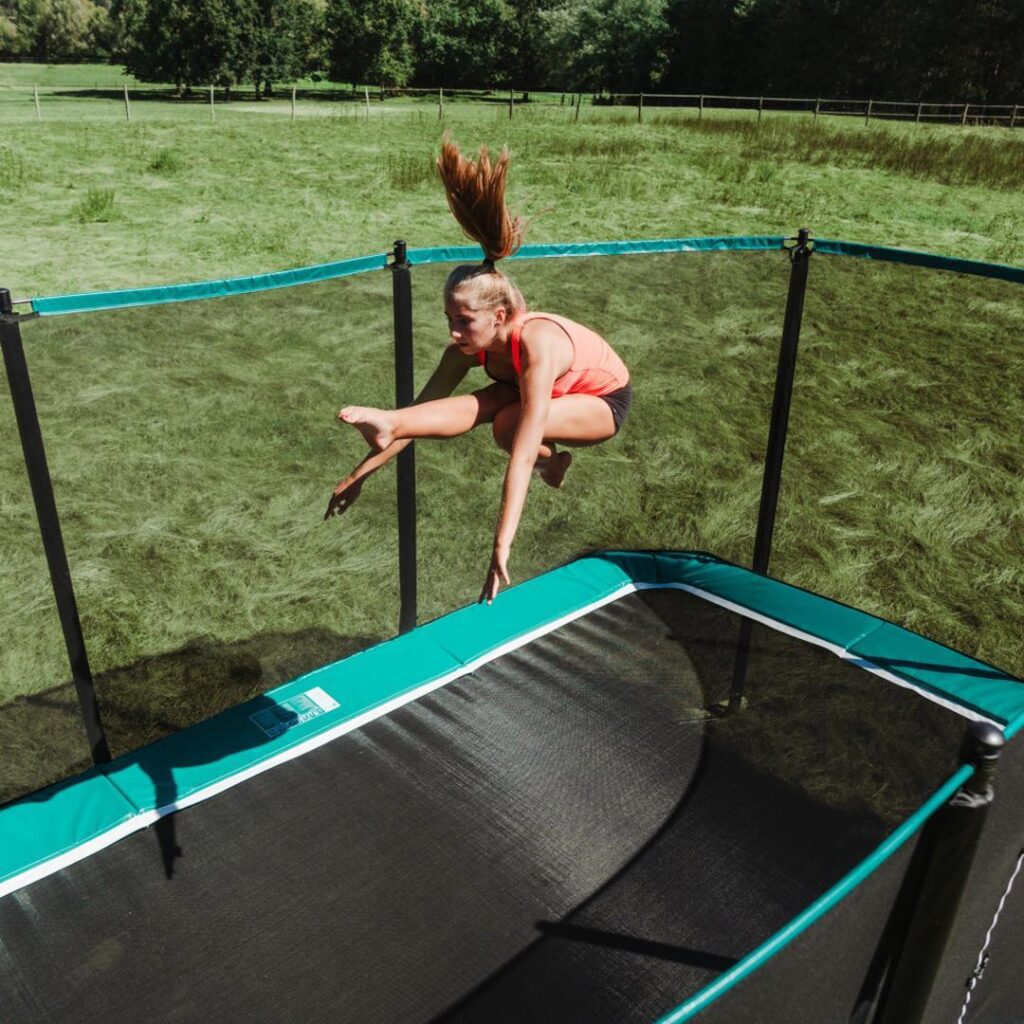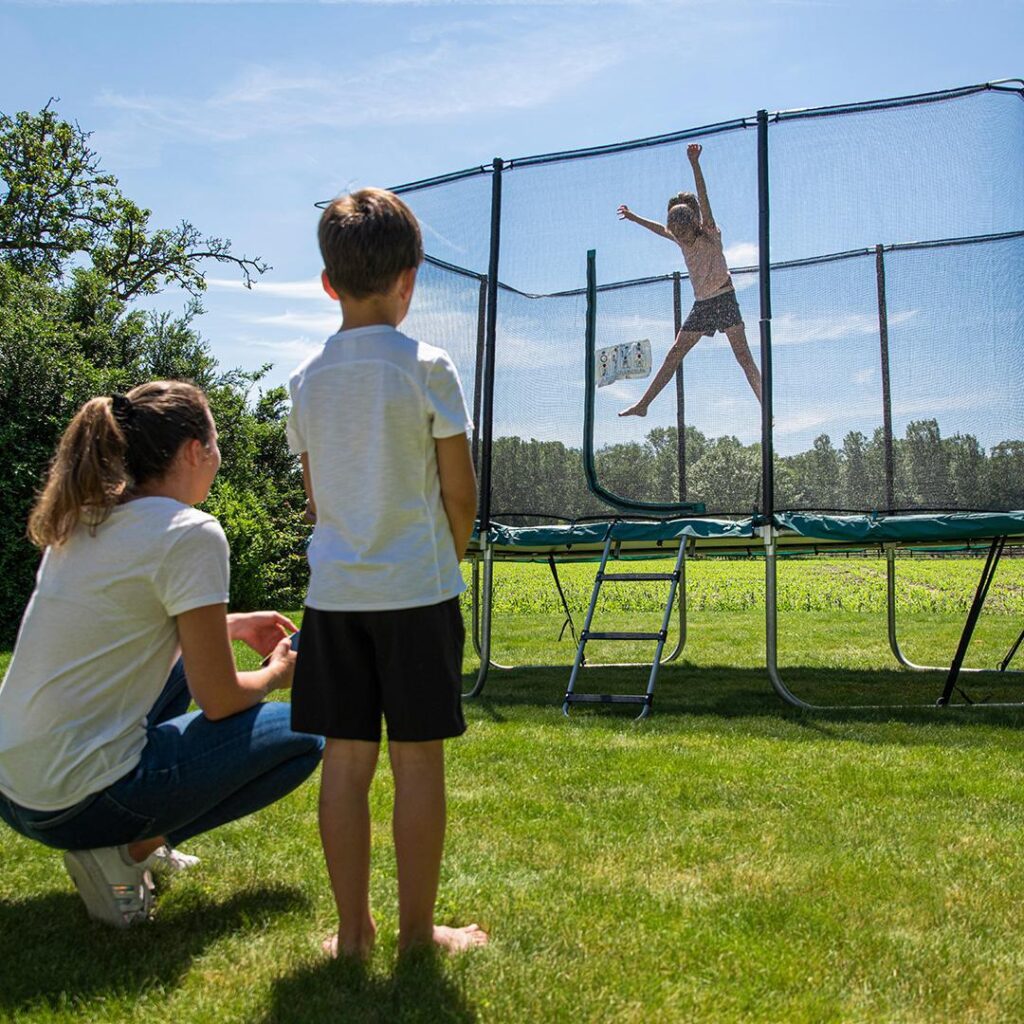
As the weather warms up, trampolines become a garden staple in many households across the UK, offering endless hours of bouncing joy for children and a nostalgic escape for adults. Whilst jumping on a garden trampoline might seem like pure child’s play, the importance of proper technique and safety precautions cannot be overstated. Trampolining, beloved by many, but its carries fair share of risks if not performed correctly. In this guide, we’ll delve into the essential practices and safety tips that should be followed to minimise the risk of injury.
1: Assemble and Position Your Trampoline Correctly
Setting Up Your Trampoline: Before diving into the fun, it’s crucial to set up your trampoline correctly. Whether it’s a brand-new setup or reassembling a stored unit, always follow the manufacturer’s guidelines meticulously. This ensures each component is properly and securely installed.
Inspection of Parts:
- Check for Damage: Inspect all parts—springs, mat, frame—for any damage or wear.
- Confirm All Parts Are Present: Ensure no pieces are missing before you begin assembly.
Choosing the Right Location:
- Surface Requirements: Place the performance trampoline on a flat, slightly soft surface like grass, which provides natural cushioning.
- Secure the Trampoline: Firmly anchor the trampoline to the ground to prevent it from moving during use or being displaced by strong winds.
Safety Clearances:
- Vertical Clearance: Maintain at least 7.3 meters of free space above the trampoline.
- Horizontal Clearance: Ensure there is at least two meters of free space around all sides of the trampoline.
Regular Manual Consultation: Always refer back to the detailed instructions in the manual provided with your trampoline. This document contains crucial information specific to your model, essential for maintaining a safe and enjoyable environment.
2: Importance of Safety Net and Edge Protection

Installation of a Safety Net: A safety net is an essential feature of any trampoline. It acts as a barrier to prevent jumpers from falling off the edge and potentially injuring themselves. Jumping, especially with multiple people, can cause someone to lose their balance due to the unpredictable movement of the trampoline.
Securing the Safety Net:
- Check the Net: Before any jumping session, ensure that the safety net is intact, with no tears or holes.
- Close the Opening: It’s vital to properly close the safety net’s entrance before anyone begins jumping. This prevents anyone from accidentally falling through the opening.
Edge Protection:
- Padding the Edges: Ensure all edges of the trampoline are equipped with adequate padding. This minimizes the risk of injury from the springs or frame, providing a safer jumping experience.
- Inspect Regularly: Regularly check the condition of the edge padding to ensure it remains secure and effective in cushioning the frame and springs.
These guidelines can significantly enhance trampoline safety, making it safer for everyone to enjoy.
3: Proper Entry and Exit Using the Safety Net Opening
Using the Designated Entry Point: The safety net opening is specifically designed as the sole entry and exit point for the trampoline. This ensures safe access and minimizes the risk of injuries that can occur from improper use.
Guidelines for Entry and Exit:
- Avoid Climbing Over: Never attempt to climb over the safety net. This can lead to falls or damage to the net itself.
- Use the Opening: Always enter and exit the trampoline through the designated opening in the safety net to maintain its integrity and safety.
Accessibility for Children:
- Consider a Ladder: For families with smaller children, adding a ladder can facilitate easier and safer access to the trampoline. This helps little ones climb aboard without the need to jump or be lifted.
- Purchase Separately: Remember that ladders are typically not included with trampolines and must be purchased separately.
Consistently using the safety net opening as the primary access point helps maintain the structure’s safety features and ensures a safer jumping experience for everyone.
4: Remember the Basic Rules
Appropriate Use of the Trampoline: Trampolines are designed specifically for jumping. It’s important to use the equipment as intended to avoid accidents and ensure everyone’s safety.
Key Guidelines for Safe Use:
- Avoid Misuse of the Safety Net: Do not climb, hang on, or intentionally crash into the safety net. Such actions can damage the net and increase the risk of injury.
- No Underneath Access: Never go under the trampoline while someone is jumping above. This can be extremely dangerous.
- Jump Within Your Ability: Start with simple jumps and gradually build your skills. Always jump within your own limits to maintain control.
- Learn to Stop: Know how to slow down and stop your jumping, especially if you feel the tempo is becoming too fast for your comfort.
- Attire for Jumping: Jump barefoot or in socks to maintain the best grip and control. Also, remove any excess clothing such as bulky jackets or jewelry that could catch or interfere with safe jumping.
Adhere to these basic rules for safe and fun Above or In-ground trampoline use.
5: One Person at a Time

Safety First: Though it might not be the most exciting rule for eager young jumpers, it’s crucial to ensure that only one person uses the trampoline at any given time. This significantly reduces the risk of collisions and accidents.
Why One at a Time?
- Collision Risk: When more than one person is on the trampoline, the risk of bumping into each other increases. This is especially true if there’s a size difference between the jumpers.
- Controlled Jumping: Even experienced jumpers can misjudge their movements and accidentally collide, leading to injuries.
Managing Turns:
- Create a Jumping Schedule: To keep things fair and organized, consider writing a list to agree on who jumps and for how long.
- Timekeeping: While one person is jumping, others can participate by timing the session, turning the wait into an engaging activity.
This approach not only ensures safety but also teaches children about taking turns and respecting rules, all while they still have fun watching and cheering each other on.
6: Jump Only in Good Weather
Weather Conditions and Safety: Weather plays a crucial role in the safety of trampoline use. Jumping during or immediately after adverse weather conditions can significantly increase the risk of accidents due to the slippery surface.
Key Points to Consider:
- Avoid Wet Surfaces: After rain, the trampoline’s surface can become very slippery, making it dangerous to use. It’s important to allow the trampoline to dry completely before anyone starts jumping again.
- Use a Protective Cover: To minimize downtime and maintain a safe jumping environment, consider using a weather cover for the trampoline when it’s not in use. This not only helps to keep the surface dry during rain but also protects the trampoline from debris and other environmental elements.
Proactive Measures: By protecting your trampoline with a cover, you can quickly resume safe jumping activities once the rain stops, without having to wait for prolonged drying times. This simple step helps ensure that the trampoline is ready to go whenever the weather improves, making your backyard fun more accessible.
7: Under Adult Supervision

Supervision is Key: A trampoline should never be used as a substitute for adult supervision. Always ensure an adult is present to monitor children as they enjoy bouncing on the trampoline. This is crucial not only to enforce safety rules but also to manage any potential risks actively.
Supervisory Tips:
- Continuous Monitoring: Dedicate time to watch over children as they use the trampoline. This can be a delightful way to spend a few hours on a sunny day, observing the joyful play.
- Neighbourhood Cooperation: If children from around the neighbourhood are using the trampoline, parents can take turns supervising. This shares the responsibility and ensures children are always safely monitored.
- Hydration and Rest Breaks: The supervising adult should remind children to take breaks and stay hydrated, especially on hot days. Fatigue can lead to a loss of coordination, increasing the risk of accidents.
Engaging Non-Jumpers: To keep waiting children entertained and prevent them from feeling left out, arrange alternative activities. Setting up outdoor games or crafts can keep them engaged while they wait for their turn on the trampoline.
Importance of Adult Presence: Constant adult supervision ensures that all safety guidelines are followed and that children understand the importance of taking turns and adhering to the rules. It also provides immediate assistance in case of any mishaps, ensuring a safer environment for everyone involved. As parent learn more safety tips for you playground trampoline to avoid an incidents!
Final Thoughts
Trampolines offer a fantastic way for children and adults alike to enjoy exercise and outdoor fun. By adhering to these guidelines—from correct setup and supervision to weather considerations and safe practices—you can ensure a safe and joyful bouncing experience for everyone. Let’s make safety a priority to keep the smiles coming and the injuries at bay.


